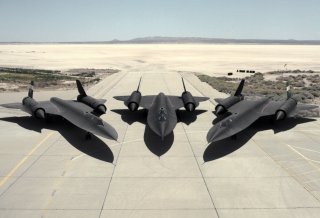How the SR-71 Blackbird Outran Over 4,000 Incoming Missiles
The SR-71 Blackbird was never once shot down through more than three decades of reconnaissance missions.
Here's What You Need to Remember: According to a 2017 report by Airman magazine, “the Blackbird evaded all 4,000 missiles fired at it and, to this day, remains the only Air Force aircraft to never lose a crewmember associated with it; whether in the air or on the ground.”
The SR-71 Blackbird is widely known as the highest-performance military jet in U.S. history. In its life, which extended from the 1960s all the way through the 1990s, the spy plane flew ever higher and faster. In fact, the SR-71 Blackbird was never once shot down through more than three decades of reconnaissance missions. This is despite those dangerous missions were usually over enemy territory and that the plane, if hit, could have been taken out.
Just how many anti-aircraft missiles missed the Blackbird over the course of its life? According to one measure, that number is somewhere around 4,000.
According to a 2017 report by Airman magazine, “the Blackbird evaded all 4,000 missiles fired at it and, to this day, remains the only Air Force aircraft to never lose a crewmember associated with it; whether in the air or on the ground.”
Another report, from We Are the Mighty, cited “Air Force data collected through pilot reports and other intelligence sources” for the 4,000 missiles figure. Brian Shul, probably the most famous pilot of the Blackbird, wrote for Gizmodo in 2014 that at the time of its retirement, “the Blackbird had outrun nearly 4,000 missiles, not once taking a scratch from enemy fire.”
Shul’s piece noted that the life of the Blackbird coincided with the terms of six U.S. presidents. Assuming the clock starts with the first mission in 1966 and ends with its retirement in 1990, those presidents were Lyndon Johnson, Richard Nixon, Gerald Ford, Jimmy Carter, Ronald Reagan and George H. W. Bush. However, Lockheed began the development of the project when Dwight Eisenhower was still in office, and had its first flight during the Kennedy Administration, and the last flights took place during the presidency of Bill Clinton.
We Are the Mighty also listed some unique facts about the SR-71 Blackbird.
The plane’s windshield, due to its extreme speed, had to be made of quartz, due to the plane giving off heat to the tune of 600 degrees Fahrenheit.
“Designers ultimately decided that using quartz for the windshield was the best way to prevent any blur or window distortion under these conditions, so they ultrasonically fused the quartz to the aircraft’s titanium hull,” the report said. The Blackbird was also the last major military aircraft to be designed using a slide rule.
“Kelly Johnson and his team used their “slide rules,” which were basically just specialized rulers with a slide that designers could use to aid them in their calculations in designing the mighty Blackbird,” We Are the Mighty said in its report. “Years later, the aircraft was reviewed using modern aviation design computers only to reveal that the machines would not have suggested any changes to the design.”
Stephen Silver, a technology writer for The National Interest, is a journalist, essayist and film critic, who is also a contributor to The Philadelphia Inquirer, Philly Voice, Philadelphia Weekly, the Jewish Telegraphic Agency, Living Life Fearless, Backstage magazine, Broad Street Review and Splice Today. The co-founder of the Philadelphia Film Critics Circle, Stephen lives in suburban Philadelphia with his wife and two sons. Follow him on Twitter at @StephenSilver. This article is being republished due to reader interest.
Image: Wikimedia.

